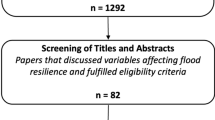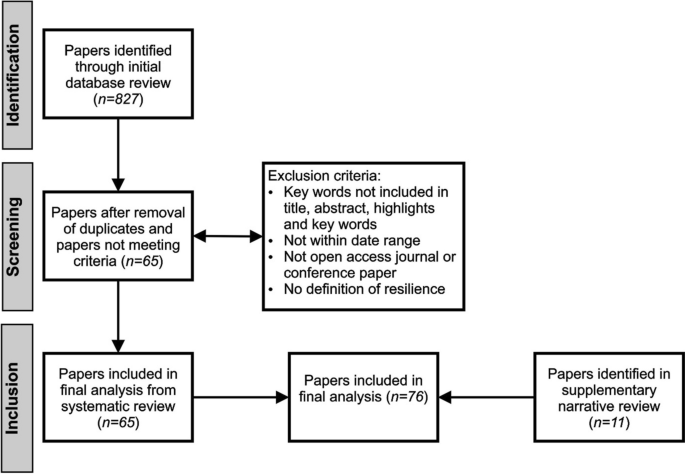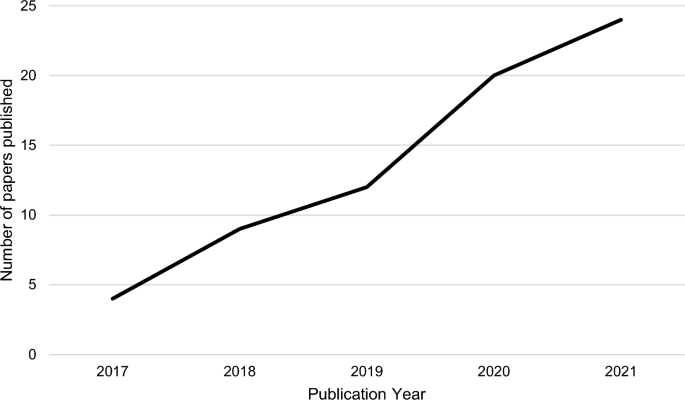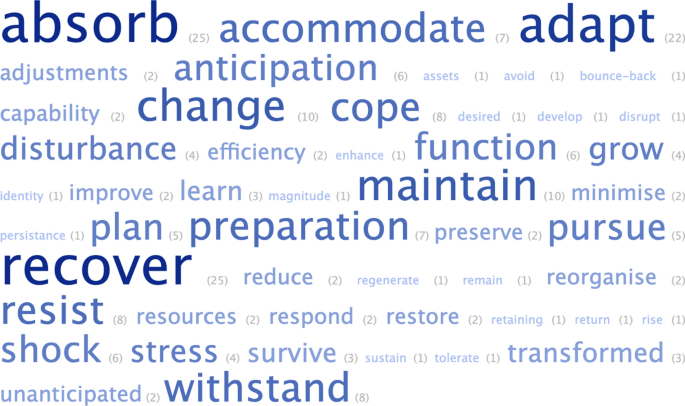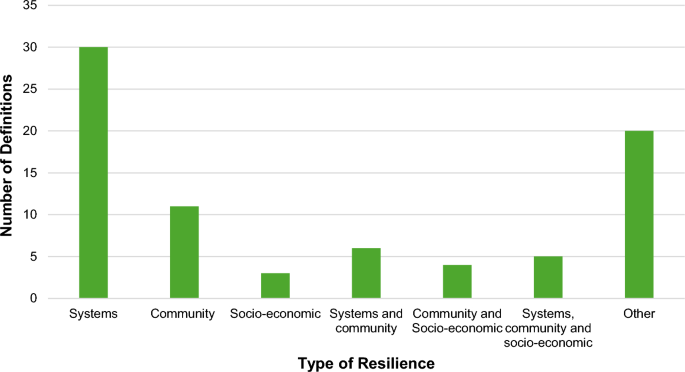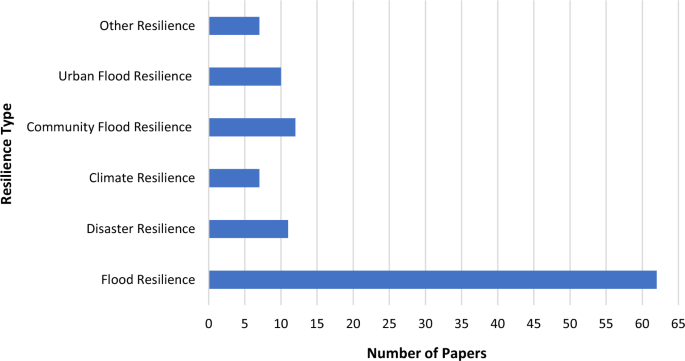Abstract
Flooding is one of the most complicated and prolific natural hazards that communities face. Added to this, more people will be affected by this hazard than any other in the future. Within recent years, there has been a notable shift in flood risk management from risk-based approaches to resilience-based. Considered a novel and necessary approach, yet no single definition of flood resilience exists. Leading to confusion surrounding the applicability of the concept. A systematic review of flood resilience definitions was hence conducted, covering a 5-year period from 2017 to 2021, resulting in 65 papers, supplemented by a narrative review (to include papers outside of the scope of the study), which added a further 11 papers. Results indicated that whilst there is no singular definition for flood resilience, there are similarities between definitions through the use of synonymous language. Whilst there is evidence of these definitions evolving over time, there is still confusion over the definition. Further research is required to further comprehend the definitions of resilience, helping to develop the use of resilience within flood sciences and corresponding flood risk management practices.
Similar content being viewed by others
Avoid common mistakes on your manuscript.
1 Introduction
The severity of hydrological hazards is ever increasing across the globe, heavily impacting the livelihood of communities worldwide (Kundzewicz and Matczak 2015), with approximately 34.2 million people being affected between 1990 and 2020 (Salas 2023). It is expected by 2050 that 70% of the world’s population will live in urban areas vulnerable to flooding (da Silva et al. 2012). Increasing the likelihood of flood-related disasters due to sheer community exposure. This risk is further compounded by ever increasing climatological changes and population pressures, with flooding expected to affect more people in the future than any other natural hazard (Hallegatte et al. 2017). Furthermore, current levels of flood adaption are considered inadequate, especially within the UK (Committee on Climate Change 2016; Percival et al. 2019), where 1 in 6 houses are at risk from flooding (Environment Agency 2023). Hence, there is an urgent need for resilient flood risk management and the research to drive it. Ensuring vulnerable communities are prepared for flooding and understand the risks they potentially face. Leading to a reduction in flood impacts including the mental and economic burdens they can have.
Flooding is a complicated and prolific hazard and one the UK for example has experienced many times over the years resulting in varying levels of impact. This includes coincident flood events, which is a combination of several flood types at once, adding further layers of complexity to an already very complicated problem (Thorne 2014). This was especially the case in the UK 2007 floods, where a combination of heavy rainfall and high-water levels caused by unusual weather (Environment Agency 2007), led to around 48,000 households being affected, 13 deaths (Cabinet Office 2008), and an economic cost of around £3.2 billion (Penning-Rosswell, 2014). This was then followed in 2013/14, where a combination of pluvial, fluvial, coastal and groundwater flooding caused significant damage to the South West of the UK, costing the economy a further £1.3 billion (Environment Agency 2016). Worldwide, there have also been several major and complicated flood events, particularly in the last 2 years, including the 2021 floods in Germany and Belgium (Copernicus 2021), the devastating 2023 Pakistan floods that affected over 30 million people (The Guardian 2023), and finally the 2023 Greek and Libyan floods where a combination of extreme rainfall and multiple dam collapse caused more than 6000 deaths (Flemming 2023; UNICEF 2023). Alas, these types of flood disasters (complex, costly and life-changing) are expected to increase drastically in the future, and a real shift in flood management from risk- based to resilience-based approaches, is vitally needed (Aven 2019). This shift is crucial to ensure management of our complex systems and reduce vulnerability within areas most at risk to flooding (Morrison et al. 2018). It is widely accepted that floods cannot be stopped from occurring, therefore learning from previous experiences to help reduce hardship and community vulnerability (resilience) is essential to help us deliver effective flood risk management (Kuang and Liao 2020).
Whilst considered a novel approach in natural hazards and flooding, resilience is widely used in other disciplines, such as psychology, ecology, and medicine. Holling (1973) first introduced the term of resilience into ecology, providing a definition referring to the persistence of systems, their ability to absorb change whilst maintaining the same relationships, similar to an equilibrium. This has provided a backbone for other fields to build on, however, within flood resilience, it has created ambiguity surrounding a definitive application of the concept, with no single definition available (Adedeji et al 2018; McClymont et al 2020a, b; Disse et al 2020), and with different branches within flood resilience (i.e., community flood resilience, urban flood resilience, climate resilience) produced, all utilising different definitions. Understanding the definitions of flood resilience is important in creating clarity within the field, which is currently lacking in several aspects of the term and the corresponding management (McClymont et al. 2020b). Whilst risk-based approaches can consider resilience within vulnerability measurements (IPCC, 2014; Percival and Teeuw 2019; Biswas 2023), it may lead to generalisation or marginalisation of resilience, and therefore reduces its significance within flood risk analyses and the measures based on them. This creates irregularities that can lead to questions regarding the dependability of the measurements and the flood risk management established due to them.
Hence this paper explored the evolution of resilience definitions within the flooding sector, discussing how differences within the definitions may be influenced by the direction of research, as well as the field in which the research is based (i.e., disaster resilience, urban resilience, flood resilience). The aim of this review being to comprehend the current definitions of flood resilience within the sector in order to enhance the applicability of this desired outcome within flood risk management and associated policies.
2 Methodology
A systematic review was conducted over a 5-year period, followed up by a supplementary narrative review, including key papers known by the authors, that may fall outside of the systematic review margins. A total of 76 papers were reviewed, outlined in Fig. 1.
A systematic review was first deployed using a pre-determined eligibility criterion, including a key word search, using the terms “Disaster Resilience” and “Flood Resilience” on Scopus and Google Scholar. This provided an opportunity to review papers not previously known by the authors, providing a comprehensive cover of the data set (Petticrew and Roberts 2008). The review was conducted over a 5-year time frame which provided a data set of n = 827 and resulted in a search from 1st January 2017 to 31st December 2021.
Initially during the screening stage, the key word searches provided over 200 results. A more enhanced search was then deployed to further hone these results. This limited the results to presence of key words in the title, abstract, key words, and highlights of search results, including:
-
Papers published within the Environmental or Social Sciences sector.
-
Papers and articles published in English.
-
Open access journals.
-
Article or conference papers.
Whilst these criteria potentially could have limited the search field, by limiting results to this specific criterion, it ensured results were focused within natural hazards, specifically resilience to flooding. A full text of each paper that met the criteria was then obtained and a final criterion was introduced (Fig. 1); contain a definition of resilience (n = 65). This was used to ensure that each of the papers were focused on resilience, and the definitions could be coded and categorised, dependent on the focus of the paper, the type of resilience discussed, and the focus of the definition.
To enhance the review dataset even further, a narrative review (Fig. 1) was conducted to provide further depth and integrity. This included papers previously known to the authors, that were outside of the search scope (i.e., outside of the 5-year timeframe) yet were seen as pioneering ideas within the resilience sector. This added an additional 11 papers to the review.
3 Results and discussion
Initial analysis of the papers indicated research within flood resilience is increasing; this is potentially due to shifts from risk-based approaches to more pragmatic resilience-based ways of thinking, with further increases expected in the future (Fig. 2). This change in perspective has also translated in the definitions of flood resilience, with over 30 definitions uncovered within this review. The previously mentioned definition provided by Holling (1973), is still assumed to be the pioneering definition, and used within multiple papers included within this review (Manyena 2006; Cutter et al. 2008). Creating a foundation for further definitions to be built upon, which is evident in many of the flood resilience definitions highlighted within this study.
A frequency analysis was also conducted during the review and showed similar language is used throughout the definitions of resilience within the dataset. The most common words were ‘absorb’ (n = 25), ‘recover’ (n = 25), and ‘adapt’ (n = 22) (Fig. 3). This language is synonymous within not only flood resilience but also flood risk and disaster risk in general. The majority of the dataset provided differing definitions of flood resilience, yet, the most common was stated in 6 papers (Atreya and Kunreuther 2016; Keating et al. 2017; Campbell et al. 2019; Rezende et al. 2019; Laurien et al 2020; Hochrainer-Stigler et al. 2020) and was provided by Keating et al., (2017) as “the ability of a system, community, or society to pursue its social, ecological, and economic development and growth objectives, while managing its disaster risk over time, in a mutually reinforcing way”. Suggesting there are different elements of flood resilience that need to be considered including aspects of our systems, our communities, and society. This definition is one of the only ones that reflects reality, as all aspects of life are considered within, this is not always the case in other definitions. Whilst some studies create diverse and well-rounded definitions, which are not specific to a singular source, this is not always the case. Haque and Doberstein’s (2021) definition of community flood resilience simplifies the term, only referencing a community’s ability to withstand external factors, with minimal support. Even though complex definitions (such as Keating et al., (2017)), provide an in depth understanding of flood resilience, simple definitions usually provide a foundation that complex definitions can be built upon, which is vital for the evolution of definitions such as flood resilience.
Early definitions of flood resilience appear to encompass a broader concept of resilience, for example Wildavsky (1991), referred to it as ‘bouncing back’ after unanticipated dangers, which overtime, becomes more focused and branches into several disciplines within flood resilience, including community, socio-economic and systems resilience, with overlap between the disciplines, as shown in Fig. 4. Papers were categorised by the focus of their definitions (Fig. 4), with systems equalling physical based approaches, community equating to definitions that consider how communities react to flooding, and socio-ecological definitions reflecting on the relationships between society and ecosystems. The ‘other’ category encompasses more generalised definitions, such as Xu et al (2021) ‘The ability to prepare and plan for, absorb, recover from, and more successfully adapt to adverse event’. These types of definitions are recorded throughout the review and are generally tautological.
McDonald-Harker et al. (2021) focused their research on resilience amongst children and youth in disasters and used a socio-economic definition of disaster resilience within the study: “capacity to navigate to health-enhancing resources that nurture individual, relational and community assets, as well as the capacity of individuals to negotiate with others for these resources to be provided to them in culturally meaningful ways", which also encompasses community resilience. However, He et al., (2021), who published just a month later, provided a definition of flood resilience predominantly relating to physical systems, their capacities, and the ability to function the same. This can be considered a systems-based definition. Even though this study is also based on social flood resilience, it uses a definition that is more engineering-based, to encompass multiple aspects of resilience. Highlighting the direction of the research/project affects how the definitions are established.
Further evidence of dichotomy can be observed between the different fields of research. Within this review, 57% of the papers were flood resilience based, with the remaining 43% split relatively equally between disaster resilience (10%), climate resilience (6%), community flood resilience (11%), urban flood resilience (9%) and other, uncategorised resilience (6%) (Fig. 5). Definitions of flood resilience between these categories differ, with some overlap between the fields. For example, there are differences between urban flood resilience and flood resilience, however, there is overlap when it comes to the socio-economic focus of the two. Wardekker et al., (2020) defines urban flood resilience as “the ability of a city or urban system to withstand a wide array of shocks and stresses”. A second definition was also provided which had a greater socio-economic base, referring to how communities, businesses and systems adapt and grow after a disaster. Within urban flood resilience, there is usually a single definition provided, sometimes combining physical and socio-economic definitions, that are not specific to just flooding, but also other natural hazards. For example, Agrawal et al., (2020), who defined resilience as “the ability of a system, community or society exposed to hazards to resist, absorb, accommodate, adapt to, transform and recover from the effects of a hazard in a timely and efficient manner, including through the preservation and restoration of its essential basic structures and functions through risk management.” Highlighting, whilst there are differences between the definitions, urban flood resilience appears to be defined in a much simpler way than flood resilience, whilst at the same time conveying a similar message. This indicates that a complex definition of flood resilience may not be required for all aspects of flood resilience, and potentially a simple one, depending on the context, could be enough.
As a relatively new concept, there is a level of evolution expected within the term flood resilience, from simplistic definitions to more advanced and specific definitions, focusing on the different aspects of flood resilience. With increasing diversity over time, it is increasingly more difficult to define flood resilience. This has been widely observed within other fields, causing a lack of convergence (Monte et al. 2021), creating confusion in emerging topics or associated management. For example, Perry (2018) discussed the evolution of definitions within disaster resilience. Whilst there is a level of evolution expected within disaster resilience, since it is a relatively new concept, this increasing diversification of the definitions is making it increasingly difficult to define, however, this could be seen as a more accurate reflection of reality.
Due to the several branches of flood resilience, (i.e. urban flood resilience, community flood resilience, coastal flood resilience) the evolution of definitions is increasingly complex, and branches in many directions. However, there is evidence of evolvement, within all sectors of flooding. For example, Murdock et al., (2018), who focused on flood resilience, provided a simple definition, referring to coping with disturbances. This was then built on by Hemmati et al., (2020), who also focused on flood resilience, by suggesting that resilience is not only the ability to cope, but also to recover and adapt to any adverse effects. Whilst these are both systems based definitions, the evolution and addition to Murdock et al., (2018) definition has provided a richer definition, that not only focuses on coping, but also recovery, which is now viewed as a key part to flood resilience. This evolution suggests that as research develops, and a greater understanding of flood resilience is developed, the definitions become increasingly diverse, and include more key features (included in Fig. 3). Whilst this is expected within novel approaches, the continuation of divergence and inclusion of differing defining features can cause complications when trying to advance science (Quarentelli, 1995) and any management and/or policies related to that science.
There is further evidence of definitions becoming more well-rounded and inclusive of all aspects of flood resilience. Whilst earlier definitions (Klein et al. (2003), Pelling (2003) and Cutter et al., (2008)) tend to focus on one aspect of flood resilience (i.e. systems or community), there is a notable increase of inclusion of 2 or more aspects of flood resilience, as early as 2005, with the UNISDR defining flood resilience as ‘The capacity of a system, community or society potentially exposed to hazards to adapt, by resisting or changing in order to reach and maintain an acceptable level of functioning and structure. This is determined by the degree to which the social system is capable of organising itself to increase this capacity for learning from past disasters for better future protection and to improve risk reduction measures’ (UNISDR, 2005; Manyena 2006). Whilst these definitions are still limited, it indicates that researchers are focusing more on the holistic element of flood resilience, with it not only being considered a social or physical component, but multi-dimensional. This idea has been adopted in other fields of resilience, such as Walker et al., (2002), who suggested that resilience could be defined using three key attributes: 1. maintenance of structure and function in the face of disturbance, 2. the ability to self-organise in response or anticipation to disturbance, 3. capacity for learning and adaptation (Bohensky and Leitch 2014). Whilst this incorporates different aspects of resilience, it could be considered as reductionist when defining flood resilience, due to the complexity/reality of its nature.
Within the UK public sector, there are also variations in the definitions, if one is even provided. Within the HM Government (2016) National Flood Resilience Review, the focus is still very much risk-based, focusing on infrastructure and defences. However, the Flood and Coastal Erosion Risk Management (FCERM) Scheme, set out by the Environment Agency, defines resilience in terms of flooding and coastal change, referring to the capacity of not only people but also places. Whilst it still refers to ‘protecting’ people and places, it also incorporates recovery and adaptation to coastal changes and climate changes (Environment Agency 2023). This shows there are further considerations of flood resilience within the governmental sector, and the understanding of the concept is developing, but not at the same rate as wider research.
Overall, whilst research into flood resilience is increasing and diversifying, there is still no one consensus on the definition of flood resilience. Due to the many branches of flood resilience, many of the definitions provided focus on different aspects of flooding, however, the flood resilience definitions can be grouped into community, socio-economic and systems resilience. These groupings provide organisation for the flood resilience definitions, with many encompassing more than one grouping (i.e. Heinzlef et al. (2019); Hochrainer-Stigler et al (2020); Slavíková, Hartmann, and Thaler, (2021)). Whilst there is evident of diversification of flood resilience definitions over time, they appear to use synonymous language (Fig. 3), yet there is very few repeated throughout the review. Hence, whilst the language used is very similar between definitions, the focus of the paper it originated from influences the definition provided, increasing the complexity of the definitions. Although this is expected, it may not be necessary for future definitions. Furthermore, though complex definitions of flood resilience can provide a deeper understanding, a simple baseline definition may be enough and more effective, especially when the definitions are being provided to the general public or other non-expert stakeholders. This definition can then be built on depending on the direction of the study/project and the stakeholders involved.
Finally, whilst this study has indicated there is a level of evolution within definitions of flood resilience, there are limitations to this study. These include the scope of the systematic review. Conducted over a span of 5 years, only more recent publications were included within the analysis. This may have created a bias towards how the term has evolved within the field due to only including more recent research. Whilst this was supplemented with a narrative review, the research’s scope was still small. Whilst the focus of this review was directed towards flood resilience, there are many other fields within natural hazards that utilise the concept of resilience, which may provide a more comprehensive definition. By expanding the criteria and timespan of the research a more comprehensive review of resilience could take place. Not only furthering our understanding of flood and disaster resilience, but also resilience to other natural hazards. Utilising previous resilience research can aid in the creation of a base definition that can be built upon within multiple hazard-related fields. Leading to a more thorough understanding of the patterns of the use of the term resilience and the definitions provided. This will allow future research to further understand previous uses of the definition, with the aim to progress definitions of resilience, to help comprehend the idea further and provide a basis for new research and effective risk management.
4 Conclusion
The frequency and intensity of natural hazards, especially flooding, are expected to increase over the coming years. Previously, research has focused on risk, however, there is a need to shift to resilience-based approaches. However, resilience is widely used within the field of social sciences and psychology; and this has created ambiguity surrounding the definition of resilience particularly in the field of natural hazards. Hence a systematic and narrative review of flood resilience via 65 papers was presented in this article and found that whilst the frequency of flood resilience research is increasing, there is still no single definition for flood resilience, creating confusion, complexity and potentially misuse of the term. Currently, flood resilience definitions are split between several fields, however they can mostly be grouped into community, socio-economic and systems resilience, with many incorporating two or more of these. The language used between the definitions is similar, however very few definitions were repeated directly. Over time, the definition has evolved, with earlier definitions being considered simple and later ones increasing in complexity. Furthermore, overtime, there is also an element of dichotomy that has influenced the definition used.
Overall, whilst there currently is no single definition for flood resilience, many of them utilise similar language, and portray similar messages. The differences are expected to be due to the novel nature of the term within the field and has been witnessed in other fields. However, for the term to become more widely used, it needs to become more definitive and ideally with a general overarching definition, that will ultimately help understanding and application of the term. Providing a foundation for resilient flood risk management protocols to be built upon, leading to sustainable and resilient responses to flooding.
References
Adedeji TJ, Proverbs DG, Xiao H, Oladokun VO (2018) Towards a conceptual framework for property level flood resilience. Int J Saf Secur Eng. https://doi.org/10.2495/SAFE-V8-N4-493-504
Agrawal N, Elliott M, Simonovic SP (2020) Risk and resilience: a case of perception versus reality in flood management. Water. https://doi.org/10.3390/w12051254
Atreya, A. and Kunreuther, H., (2016). Measuring community resilience: the role of the community rating system (CRS). https://doi.org/10.2139/ssrn.2788230
Aven T (2019) The call for a shift from risk to resilience: What does it mean? Risk Anal. https://doi.org/10.1111/risa.13247
Biswas S (2023) A review of socio-economic vulnerability: the emergence of its theoretical concepts, models and methodologies. Nat Hazards Res. https://doi.org/10.1016/j.nhres.2023.05.005
Bohensky EL, Leitch AM (2014) Framing the flood: a media analysis of themes of resilience in the 2011 Brisbane flood. Reg Environ Change. https://doi.org/10.1007/s10113-013-0438-2
Campbell KA, Laurien F, Czajkowski J, Keating A, Hochrainer-Stigler S, Montgomery M (2019) First insights from the flood resilience measurement tool: a large-scale community flood resilience analysis. Int J Disaster Risk Reduct. https://doi.org/10.1016/j.ijdrr.2019.101257
Committee on Climate Change (2016) UK Climate Change Risk Assessment 2017 – Synthesis Report: Priorities for the Next Five Years
Copernicus (2021) Flooding in Europe. [Online] Available at: https://climate.copernicus.eu/esotc/2021/flooding-july#:~:text=Extreme%20flooding%20occurred%20in%20parts,was%20the%20highest%20on%20record. [Accessed: 21/04/2023]
Cutter SL, Barnes L, Berry M, Burton C, Evans E, Tate E, Webb J (2008) A place-based model for understanding community resilience to natural disasters. Glob Environ Chang. https://doi.org/10.1016/j.gloenvcha.2008.07.013
Da Silva J, Kernaghan S, Luque A (2012) A systems approach to meeting the challenges of urban climate change. Int J Urb Sustain Dev. https://doi.org/10.1080/19463138.2012.718279
Disse M, Johnson TG, Leandro J, Hartmann T (2020) Exploring the relation between flood risk management and flood resilience. Water Secur. https://doi.org/10.1016/j.wasec.2020.100059
Environment Agency (2007) Review of 2007 Summer Floods [Online] Available at: https://assets.publishing.service.gov.uk/media/5a7c9a55ed915d6969f460bd/geho1107bnmi-e-e.pdf [Accessed: 20/4/2023]
Environment Agency (2016) The costs and impacts of the winter 2013 to 2014 floods- Summary [Online] Available at: https://assets.publishing.service.gov.uk/media/60354956d3bf7f0ab6856b56/The_costs_and_impacts_of_the_winter_2013_to_2014_floods_-_summary.pdf [Accessed: 11/09/23]
Environment Agency (2023) Building back better and mainstream property flood resilience. [Online] Available at: https://environmentagency.blog.gov.uk/2023/05/22/building-back-better-and-mainstreaming-property-flood-resilience/ [Accessed: 06/04/2023]
Flemming, L., (2023) Libya Floods: Entire neighbourhoods dragged into the sea. BBC News [Online] 12th September 2023. Available at: https://www.bbc.co.uk/news/world-africa-66785466 [Accessed: 30/09/2023]
Guardian, The. (2023) At least 50 dead in Pakistan monsoon floods since end of June. The Guardian [Online]. 7th July 2023. Available at: https://www.theguardian.com/world/2023/jul/07/pakistan-monsoon-floods-punjab-province-deaths?CMP=share_btn_url
Hallegatte, S., Vogt-Schilb, A., Bangalore, M. & Rozenberg, J. (2017) Unbreakable: Building the Resilience of the Poor in the Face of Natural Disasters Ch. 3, 63–77.
Haque CE, Doberstein B (2021) Adaptive governance and community resilience to cyclones in coastal Bangladesh: addressing the problem of fit, social learning, and institutional collaboration. Environ Sci Policy. https://doi.org/10.1016/j.envsci.2021.08.007
He H, Delang CO, Zhou J, Li Y, He W (2021) Simulation of social resilience affected by extreme events in ancient China. Clim Change. https://doi.org/10.1007/s10584-021-03134-9
Heinzlef C, Becue V, Serre D (2019) Operationalizing urban resilience to floods in embanked territories–application in Avignon. Provence Alpes Côte D’azur Reg Saf Sci. https://doi.org/10.1016/j.ssci.2019.05.003
Hemmati M, Ellingwood BR, Mahmoud HN (2020) The role of urban growth in resilience of communities under flood risk. Earth’s Future. https://doi.org/10.1029/2019EF001382
HM Government (2016) National Flood Resilience Review [Online] Available at: https://assets.publishing.service.gov.uk/media/5a7f973de5274a2e8ab4d1af/national-flood-resilience-review.pdf [Accessed: 23/08/2023]
Hochrainer-Stigler S, Laurien F, Velev S, Keating A, Mechler R (2020) Standardized disaster and climate resilience grading: a global scale empirical analysis of community flood resilience. J Environ Manage. https://doi.org/10.1016/j.jenvman.2020.111332
Holling CS (1973) Resilience and stability of ecological systems. Annu Rev Ecol Syst 4(1):1–23. https://doi.org/10.1146/annurev.es.04.110173.000245
IPCC (2014) Summary for policymakers. In: Climate change 2014: impacts, adaptation, and vulnerability. Part A: global and sectoral aspects. Contribution of working group II to the fifth assessment report of the intergovernmental panel on climate change [Field CB, Barros VR, Dokken DJ, Mach KJ, Mastrandrea MD, Bilir TE, Chatterjee M, Ebi KL, Estrada YO, Genova RC, Girma B, Kissel ES, Levy AN, MacCracken S, Mastrandrea PR, White LL (eds)] Cambridge University Press, Cambridge, New York, NY.
Keating A, Campbell K, Mechler R, Magnuszewski P, Mochizuki J, Liu W, Szoenyi M, McQuistan C (2017) Disaster resilience: what it is and how it can engender a meaningful change in development policy. Dev Policy Rev. https://doi.org/10.1111/dpr.12201
Klein RJ, Nicholls RJ, Thomalla F (2003) Resilience to natural hazards: How useful is this concept? Glob Environ Change Part b: Environ Hazards. https://doi.org/10.1016/j.hazards.2004.02.001
Kuang D, Liao KH (2020) Learning from floods: linking flood experience and flood resilience. J Environ Manage. https://doi.org/10.1016/j.jenvman.2020.111025
Kundzewicz ZW, Matczak PIOTR (2015) Hydrological extremes and security. Proc Int Assoc Hydrol Sci. https://doi.org/10.5194/piahs-366-44-2015
Laurien F, Hochrainer-Stigler S, Keating A, Campbell K, Mechler R, Czajkowski J (2020) A typology of community flood resilience. Reg Environ Change. https://doi.org/10.1007/s10113-020-01593-x
Manyena SB (2006) The concept of resilience revisited. Disasters. https://doi.org/10.1111/j.0361-3666.2006.00331.x
McClymont K, Cunha DGF, Maidment C, Ashagre B, Vasconcelos AF, de Macedo MB, Dos Santos MFN, Júnior MNG, Mendiondo EM, Barbassa AP, Rajendran L (2020a) Towards urban resilience through Sustainable Drainage Systems: A multi-objective optimisation problem. J Environ Manage. https://doi.org/10.1016/j.jenvman.2020.111173
McClymont K, Morrison D, Beevers L, Carmen E (2020b) Flood resilience: a systematic review. J Environ Planning Manage. https://doi.org/10.1080/09640568.2019.1641474
McDonald-Harker C, Drolet J, Sehgal A (2021) A strength-based approach to exploring factors that contribute to resilience among children and youth impacted by disaster. Br J Soc Work. https://doi.org/10.1093/bjsw/bcab109
Monte BEO, Goldenfum JA, Michel GP, de Albuquerque Cavalcanti JR (2021) Terminology of natural hazards and disasters: a review and the case of Brazil. Int J Disaster Risk Reduct. https://doi.org/10.1016/j.ijdrr.2020.101970
Morrison A, Westbrook CJ, Noble BF (2018) A review of the flood risk management governance and resilience literature. J Flood Risk Manag. https://doi.org/10.1111/jfr3.12315
Murdock HJ, De Bruijn KM, Gersonius B (2018) Assessment of critical infrastructure resilience to flooding using a response curve approach. Sustainability. https://doi.org/10.3390/su10103470
Office C (2008) The pitt review: lessons learned from the 2007 floods. Cabinet Office, London
Pelling M (2003) The Vulnerability of cities: natural disasters and social resilience. Earthscan, London
Penning-Rowsell EC (2014) A realistic assessment of fluvial and coastal flood risk in England and Wales. Trans Inst Br Geogr. https://doi.org/10.1111/tran.12053
Percival S, Gaterell M, Teeuw R (2019) Urban neighbourhood flood vulnerability and risk assessments at different diurnal levels. J Flood Risk Manag. https://doi.org/10.1111/jfr3.12466
Percival S, Teeuw R (2019) A methodology for urban micro-scale coastal flood vulnerability and risk assessment and mapping. Nat Hazards. https://doi.org/10.1007/s11069-019-03648-7
Perry RW (2018) Defining disaster: an evolving concept. In Handbook of Disaster Research. https://doi.org/10.1007/978-3-319-63254-4_1
Petticrew, M. and Roberts, H., (2008). Systematic reviews in the social sciences: A practical guide.
Rezende OM, Miranda FM, Haddad AN, Miguez MG (2019) A framework to evaluate urban flood resilience of design alternatives for flood defence considering future adverse scenarios. Water. https://doi.org/10.3390/w11071485
Salas, E.B., (2023) Global number of people affected by floods 1990–2022. [Online] Available at: https://www.statista.com/statistics/1293353/global-number-of-people-affected-by-floods/ [Accessed: 03/04/2023]
Slavíková, L., Hartmann, T. and Thaler, T., 2021. Paradoxes of financial schemes for resilient flood recovery of households. Wiley Interdisciplinary Reviews: Water. https://doi.org/10.1002/wat2.1497
Thorne C (2014) Geographies of UK flooding in 2013/4. Geogr J. https://doi.org/10.1111/geoj.12122
UNICEF (2023) Devastating Floods in Libya [Online] Available at: https://www.unicef.org/emergencies/devastating-flooding-libya [Accessed: 30/09/2023]
UNISDR (United Nations International Strategy for Disaster Risk Reduction) (2005) Hyogo Framework for 2005–2015: Building the Resilience of Nations and Communities to Disasters. [Online]. Available at: https://www.unisdr.org/2005/wcdr/intergover/official-doc/L-docs/Hyogo-framework-for-action-english.pdf [Accessed: 6/12/2022]
Walker B, Carpenter S, Anderies J, Abel N, Cumming G, Janssen M, Lebel L, Norberg J, Peterson GD, Pritchard R (2002) Resilience management in social-ecological systems: a working hypothesis for a participatory approach. Conserv Ecol. https://doi.org/10.5751/ES-00356-060114
Wardekker A, Wilk B, Brown V, Uittenbroek C, Mees H, Driessen P, Wassen M, Molenaar A, Walda J, Runhaar H (2020) A diagnostic tool for supporting policymaking on urban resilience. Cities. https://doi.org/10.1016/j.cities.2020.102691
Wildavsky A.(1991). Searching for Safety. Transaction Books.
Xu W, Cong J, Proverbs D, Zhang L (2021) An evaluation of urban resilience to flooding. Water. https://doi.org/10.3390/w13152022
Funding
The authors have not disclosed any funding.
Author information
Authors and Affiliations
Corresponding author
Ethics declarations
Conflict of interest
The authors have not disclosed any competing interests.
Additional information
Publisher's Note
Springer Nature remains neutral with regard to jurisdictional claims in published maps and institutional affiliations.
Rights and permissions
Open Access This article is licensed under a Creative Commons Attribution 4.0 International License, which permits use, sharing, adaptation, distribution and reproduction in any medium or format, as long as you give appropriate credit to the original author(s) and the source, provide a link to the Creative Commons licence, and indicate if changes were made. The images or other third party material in this article are included in the article's Creative Commons licence, unless indicated otherwise in a credit line to the material. If material is not included in the article's Creative Commons licence and your intended use is not permitted by statutory regulation or exceeds the permitted use, you will need to obtain permission directly from the copyright holder. To view a copy of this licence, visit http://creativecommons.org/licenses/by/4.0/.
About this article
Cite this article
Laidlaw, S., Percival, S. Flood resilience: a review of evolving definitions. Nat Hazards (2024). https://doi.org/10.1007/s11069-024-06627-9
Received:
Accepted:
Published:
DOI: https://doi.org/10.1007/s11069-024-06627-9




